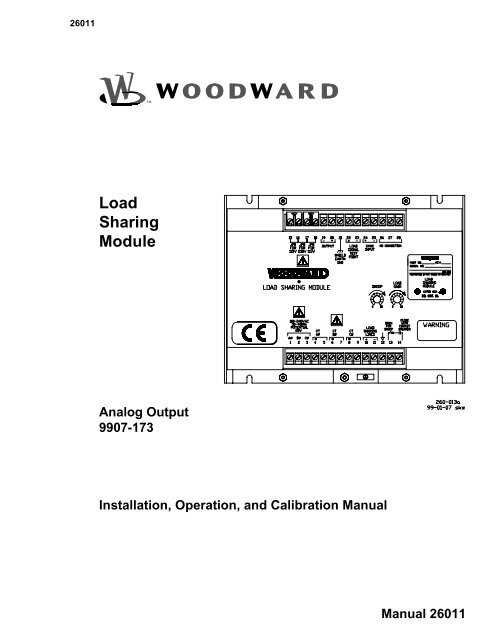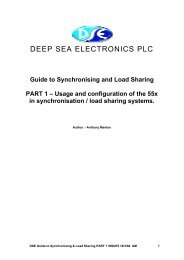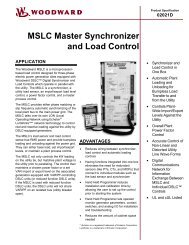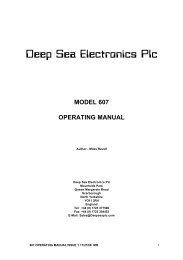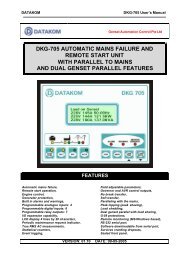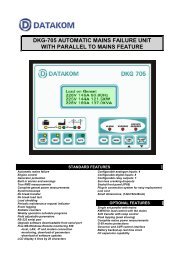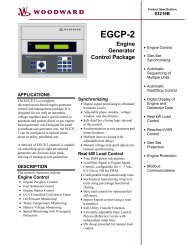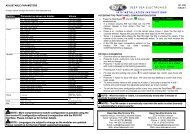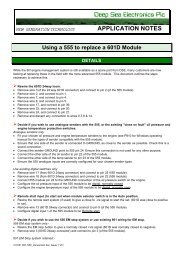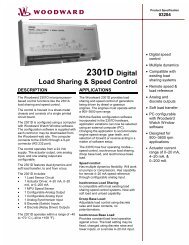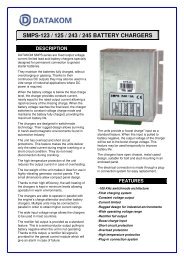Load Sharing Module - Home Mega Global Solution
Load Sharing Module - Home Mega Global Solution
Load Sharing Module - Home Mega Global Solution
You also want an ePaper? Increase the reach of your titles
YUMPU automatically turns print PDFs into web optimized ePapers that Google loves.
26011<strong>Load</strong><strong>Sharing</strong><strong>Module</strong>Analog Output9907-173Installation, Operation, and Calibration ManualManual 26011
!WARNINGRead this entire manual and all other publications pertaining to the work tobe performed before installing, operating, or servicing this equipment.Practice all plant and safety instructions and precautions. Failure to followinstructions can cause personal injury and/or property damage.The engine, turbine, or other type of prime mover should be equipped withan overspeed (overtemperature, or overpressure, where applicable)shutdown device(s), that operates totally independently of the prime movercontrol device(s) to protect against runaway or damage to the engine,turbine, or other type of prime mover with possible personal injury or loss oflife should the mechanical-hydraulic governor(s) or electric control(s), theactuator(s), fuel control(s), the driving mechanism(s), the linkage(s), or thecontrolled device(s) fail.!!!!CAUTIONDo not attempt to service the unit beyond that described in the operatinginstructions. All other servicing should be referred to qualified servicepersonnel.CAUTIONTo prevent damage to a control system that uses an alternator or batterychargingdevice, make sure the charging device is turned off beforedisconnecting the battery from the system.CAUTIONElectronic controls contain static-sensitive parts. Observe the followingprecautions to prevent damage to these parts.• Discharge body static before handling the control (with power to thecontrol turned off, contact a grounded surface and maintain contact whilehandling the control).• Avoid all plastic, vinyl, and styrofoam (except antistatic versions)around printed circuit boards.• Do not touch the components or conductors on a printed circuit boardwith your hands or with conductive devices.CAUTIONTo maintain compliance with CE marking requirements, the European UnionLow Voltage Directive requires that the <strong>Load</strong> <strong>Sharing</strong> <strong>Module</strong> (LSM) bemounted in an IP43 enclosure as defined in EN60529. Access to the <strong>Load</strong><strong>Sharing</strong> <strong>Module</strong> must be restricted to qualified personnel.Woodward Governor Company reserves the right to update any portion of this publication at any time. Informationprovided by Woodward Governor Company is believed to be correct and reliable. However, no responsibility isassumed by Woodward Governor Company unless otherwise expressly undertaken.© 1999 by Woodward Governor CompanyAll Rights Reserved
Manual 26011Chapter 1General Information<strong>Load</strong> <strong>Sharing</strong> <strong>Module</strong>IntroductionThe Woodward <strong>Load</strong> <strong>Sharing</strong> <strong>Module</strong> is made for use with engines equipped withspeed controls that accept a –4.5 to +1.5 Vdc speed setting. The <strong>Load</strong> <strong>Sharing</strong><strong>Module</strong> allows use of Woodward power generation accessories and allows loadsharing between engines equipped with speed controls that are not manufacturedby Woodward and engines controlled with Woodward electronic controls, orcontrols using other Woodward load sharing modules.DescriptionThe <strong>Load</strong> <strong>Sharing</strong> <strong>Module</strong> provides isochronous and droop load-sharing capabilityfor engines in generator set applications. Additional equipment in the controlsystem can include the Woodward SPM-A Synchronizer, Paralleling PhaseSwitch, Import/Export Control, Precision Frequency Control, AutomaticGenerator <strong>Load</strong>ing Control, and Automatic Power Transfer and <strong>Load</strong>ing Control.Figure 1-1 shows a typical system using a <strong>Load</strong> <strong>Sharing</strong> <strong>Module</strong>.Figure 1-1. Typical System Using a <strong>Load</strong> <strong>Sharing</strong> <strong>Module</strong>Woodward 1
<strong>Load</strong> <strong>Sharing</strong> <strong>Module</strong> Manual 26011Figure 1-2. Outline Drawing of <strong>Load</strong> <strong>Sharing</strong> <strong>Module</strong>2 Woodward
Manual 26011<strong>Load</strong> <strong>Sharing</strong> <strong>Module</strong>Figure 1-3. Plant Wiring Diagram of <strong>Load</strong> <strong>Sharing</strong> <strong>Module</strong>Woodward 3
<strong>Load</strong> <strong>Sharing</strong> <strong>Module</strong> Manual 26011Figure 1-4. Block Diagram of <strong>Load</strong> <strong>Sharing</strong> <strong>Module</strong>4 Woodward
Manual 26011<strong>Load</strong> <strong>Sharing</strong> <strong>Module</strong>Chapter 2Electrostatic Discharge AwarenessAll electronic equipment is static-sensitive, some components more than others. Toprotect these components from static damage, you must take special precautions tominimize or eliminate electrostatic discharges.!CAUTIONTo prevent possible serious damage to the <strong>Load</strong> <strong>Sharing</strong> <strong>Module</strong>, donot attempt to service the unit beyond that described in the operatinginstructions. All other servicing should be referred to qualifiedservice personnel.Follow these precautions when working with or near the <strong>Load</strong> <strong>Sharing</strong> <strong>Module</strong>.1. Before doing maintenance on the <strong>Load</strong> <strong>Sharing</strong> <strong>Module</strong>, discharge the staticelectricity on your body to ground by touching and holding a grounded metalobject (pipes, cabinets, equipment, etc.).2. Avoid the build-up of static electricity on your body by not wearing clothingmade of synthetic materials. Wear cotton or cotton-blend materials as muchas possible because these do not store static electric charges as much assynthetics.3. Keep plastic, vinyl, and styrofoam materials (such as plastic or styrofoamcups, cup holders, cigarette packages, cellophane wrappers, vinyl books orfolders, plastic bottles, and plastic ash trays) away from the <strong>Load</strong> <strong>Sharing</strong><strong>Module</strong>, the modules, and the work area as much as possible.4. Do not remove the printed circuit board (PCB) from the electronic cabinetunless absolutely necessary, and then only after all input power has beenremoved from the unit. If you must remove the PCB from the electroniccabinet, follow these precautions:• Do not touch any part of the PCB except the edges.• Do not touch the electrical conductors, the connectors, or thecomponents with conductive devices or with your hands.• When replacing a PCB, keep the new PCB in the plastic antistaticprotective bag it comes in until you are ready to install it. Immediatelyafter removing the old PCB from the electronic cabinet, place it in theantistatic protective bag.Woodward 5
<strong>Load</strong> <strong>Sharing</strong> <strong>Module</strong> Manual 260116 Woodward
Manual 26011Chapter 3Installation<strong>Load</strong> <strong>Sharing</strong> <strong>Module</strong>IntroductionThis section contains general installation instructions for the <strong>Load</strong> <strong>Sharing</strong><strong>Module</strong>. Environmental precautions and location considerations are included todetermine the best location for the <strong>Load</strong> <strong>Sharing</strong> <strong>Module</strong>. Additional informationincludes unpacking instructions, electrical connections, and an installation checkoutprocedure.UnpackingBefore handling the <strong>Load</strong> <strong>Sharing</strong> <strong>Module</strong>, read Chapter 2, ElectrostaticDischarge Awareness. Be careful when unpacking the <strong>Load</strong> <strong>Sharing</strong> <strong>Module</strong>.Check the unit for signs of damage such as bent or dented panels, scratches, andloose or broken parts. Notify the shipper of any damage.Location ConsiderationsConsider these requirements when selecting the mounting location:• Adequate ventilation for cooling• Space for servicing and repair• Protection from direct exposure to water or to a condensation-proneenvironment• Protection from high-voltage or high-current devices, or devices whichproduce electromagnetic interference• Protection from excessive vibration• An ambient operating temperature range of –40 to +70 °C (–40 to +158 °F)Do not mount the <strong>Load</strong> <strong>Sharing</strong> <strong>Module</strong> on the engine.Figure 1-2 is an outline drawing of the <strong>Load</strong> <strong>Sharing</strong> <strong>Module</strong>. Install the unit asclose as practical to the electronic engine control, but not on the engine itself. Itmay be installed in any position.To maintain compliance with CE marking requirements, the European Union LowVoltage Directive requires that the <strong>Load</strong> <strong>Sharing</strong> <strong>Module</strong> (LSM) be mounted in anIP43 enclosure as defined in EN60529. Access to the <strong>Load</strong> <strong>Sharing</strong> <strong>Module</strong> mustbe restricted to qualified personnel.Woodward 7
<strong>Load</strong> <strong>Sharing</strong> <strong>Module</strong> Manual 26011General Wiring RequirementsThe circled ground symbol identifies the Protective Earth Terminal.This terminal must be connected directly to protective earth using agrounding conductor at least as large as those used on terminals 1through 9. The insulation of the grounding conductor must be of greenand yellow color.This symbol identifies functional or EMC earth. This terminal is to beused for cable shield connections only. It is not to be used as aprotective earth terminal.External wiring connections and shielding requirements for a typical installationare shown in the plant wiring diagram, Figure 1-3. These wiring connections andshielding requirements are explained in more detail in this chapter.To maintain compliance with CE marking requirements, the Low VoltageDirective requires that the <strong>Load</strong> <strong>Sharing</strong> <strong>Module</strong> must only be connected to ClassIII equipment.Wiring for the <strong>Load</strong> <strong>Sharing</strong> <strong>Module</strong> must be suitable for at least 90 °C (194 °F)and also be suitable for the maximum installed operating temperature.The <strong>Load</strong> <strong>Sharing</strong> <strong>Module</strong> must be permanently connected and employ fuses orcircuit breakers in each of the PT lines to limit current to the LSM PT inputs to nomore than 5 A.All terminal block screws must be tightened to 0.56 to 0.79 N·m (5.0 to 7.0 lb-in).To maintain compliance with CE marking requirements, the EMC Directiverequires that all shields be connected to the terminals provided per the plant wiringdiagram, Figure 1-3.Power RequirementsThe <strong>Load</strong> <strong>Sharing</strong> <strong>Module</strong> is powered from the potential transformer connections.Jumpers are used to set the module for the voltage being produced by thegenerator. Jumper terminals 15 to 16 and 17 to 18 when the generator is producing95 to 130 Vac. Jumper terminal 16 to 17 when the generator is producing 190 to260 Vac. Potential transformer burden is 1.6 W per phase with 230 Vac input and0.4 W per phase with 115 Vac input.!CAUTIONMake only jumper connections to terminals 15 through 18. DO NOTMAKE ANY ELECTRICAL CONNECTIONS to these terminals.8 Woodward
Manual 26011<strong>Load</strong> <strong>Sharing</strong> <strong>Module</strong>The unit is shipped with terminals 15–16 and 17–18 jumpered for 95 to 130 voltgeneration. To change to 190–260 volt generation, remove both jumpers andinstall one of the jumpers across terminals 16–17. The other jumper is then notused.Shielded WiringAll shielded cable must be twisted conductors with either a foil or braided shield.Do not attempt to tin (put solder on) the braided shield. All signal lines should beshielded to prevent picking up stray signals from adjacent equipment. Connect theshields to the terminals indicated in the plant wiring diagram. Wire exposedbeyond the shield must be as short as possible.The other end of the shields must be left open and insulated from any otherconductor. Do not run shielded signal wires with other wires carrying largecurrents. See Application Note 50532, EMI Control for Electronic GoverningSystems, for more information.Where shielded cable is required, cut the cable to the desired length and preparethe cable as instructed below and shown in Figure 3-1.Figure 3-1. Preparation of Shielded Cables1. Strip outer insulation from both ends, exposing the braided or spiral wrappedshield. Do not cut the shield on the end nearest to the <strong>Load</strong> <strong>Sharing</strong> <strong>Module</strong>.Cut off the shield on the end away from the unit.2. Use a sharp, pointed tool to carefully spread the strands of the shield.3. Pull the inner conductors out of the shield. Twist braided shields to preventfraying.4. Connect lugs to the shield and to the control wires. Number 6 slotted or roundcrimp-on terminals are used for most installations. Connect the wires to theappropriate terminals on the module.Woodward 9
<strong>Load</strong> <strong>Sharing</strong> <strong>Module</strong> Manual 26011Installations with severe electromagnetic interference (EMI) may require shieldedwire run in conduit, double shielded wire, or other precautions.Generator Connections NOTEUse 1 mm² (18 AWG) or larger wire for all PT and CT connections.The spacing between the lugs on terminals 3 and 4 must be 6.5 mm(0.256 inch) or greater to comply with the European Union LowVoltage Directive (see Figure 1-3). The lugs must have insulatedsleeves. IMPORTANTConnections from the potential transformers and currenttransformers must be made correctly in regard to the three phasesfor the <strong>Load</strong> <strong>Sharing</strong> <strong>Module</strong> to operate correctly. Sorting out thethree phases at the module is tedious and requires numerousgenerator starts and stops. If at all possible, make sure that the wiringis correctly done at the time of installation and the phases correctlyand permanently identified at the generator and at the module.Connect the PT output from the A leg to terminal 1. Connect the PT output fromthe B leg to terminal 2. Connect the PT output from the C leg to terminal 3. Sizethe potential transformers to produce 100–240 Vac.Current TransformersPower source current transformers should be sized to produce 5 A secondarycurrent with maximum generator current (3–7 A secondary current at full load isacceptable). CT burden is 0.1 VA. To prevent lethal high voltage from developingon leads to the terminals, the <strong>Load</strong> <strong>Sharing</strong> <strong>Module</strong> contains internal burden whichmust be connected across the power source current transformers whenever the unitis running. Ammeters may be installed on the leads from the current transformers.Connect phase “A” CT to terminals 4 and 5. Connect phase “B” CT to terminals 6and 7. Connect Phase “C” CT to terminals 8 and 9. Observe correct phasing asshown in the plant wiring diagram, Figure 1-3.10 Woodward
Manual 26011<strong>Load</strong> <strong>Sharing</strong> <strong>Module</strong><strong>Load</strong> <strong>Sharing</strong> Lines, Droop, and Auxiliary ContactsThe droop contact for selecting droop or isochronous operation is wired in serieswith the circuit breaker auxiliary contact between terminals 13 and 14. When boththe droop contact and circuit breaker auxiliary contact are closed, the <strong>Load</strong><strong>Sharing</strong> <strong>Module</strong> is in the isochronous load sharing mode. In this mode the internalload-sharing-line relay is energized, the droop signal is disabled, and the loadmatching circuit is connected to the load-sharing lines, permitting isochronous loadsharing.The <strong>Load</strong> <strong>Sharing</strong> <strong>Module</strong> is in the droop mode when EITHER the droop contactor the circuit breaker auxiliary contact is open. If the droop contact is open, the<strong>Load</strong> <strong>Sharing</strong> <strong>Module</strong> remains in the droop mode even when the circuit breakerauxiliary contact is closed. If droop is not desired when the auxiliary contact isopen, turn the droop potentiometer fully counterclockwise.Use a single pole, single-throw switch with a 0.1 A minimum rating for the “openfor droop” switch.Output to the Engine Speed ControlUse twisted 0.5 mm² (20 AWG) or larger shielded wire to connect the outputsignal from terminals 19, 20, and 21 to the engine speed control. Connect theshield to the closest chassis screw only. Do not connect the shield at the speedcontrol end of the wiring.Synchronization ConnectionsIf an SPM-A synchronizer is used, connect twisted-pair 0.5 mm² (20 AWG) orlarger shielded wire from the synchronizer to terminals 24(+) and 25(–). Tie theshield to the closest chassis screw. Do not connect the shield at the synchronizerend of the wiring.Woodward 11
<strong>Load</strong> <strong>Sharing</strong> <strong>Module</strong> Manual 2601112 Woodward
Manual 26011Chapter 4Setup and Calibration<strong>Load</strong> <strong>Sharing</strong> <strong>Module</strong>IntroductionUse this calibration procedure after a <strong>Load</strong> <strong>Sharing</strong> <strong>Module</strong> is installed on agenerator set, to obtain the needed operating characteristics during load sharing.1. Check the input power on terminals 15(+) to 16(–) for 24 Vdc. Properpolarity must be maintained.2. Remove wires from load sharing line terminals 10 and 11, and from theSPM-A Synchronizer (if used) at terminals 24 and 25.3. Select isochronous operation by shorting terminals 13 and 14.!WARNINGTO PROTECT AGAINST POSSIBLE PERSONAL INJURY, LOSS OFLIFE, and/or PROPERTY DAMAGE EACH TIME you START the engine,turbine, or other type of prime mover, BE PREPARED TO MAKE ANEMERGENCY SHUTDOWN to protect against runaway or overspeedshould the mechanical-hydraulic governor(s), or electric control(s),the actuator(s), fuel control(s), the driving mechanism(s), thelinkage(s), or the control devices fail.4. Start the engine according to the engine manufacturer’s instructions. Adjustthe engine for rated speed. Apply full load to the generator set. NOTEThe most accurate calibration is made at full load. However, if it is notpossible to run the generator set at full load, run it at less than fullload, and reduce the voltage readings given in this calibrationprocedure proportionally. For example: run a 200 kW generator set at100 kW and divide all voltages given in this calibration procedure by2. If you reduce the load in this manner, be sure to reduce it by thesame amount throughout the calibration procedure.5. Set the LOAD GAIN potentiometer fully clockwise.6. Check the load signal voltage between terminals 22 and 23. Adjust the LOADGAIN potentiometer for 6.0 Vdc signal. If this voltage is not obtainable, setthe load signal as close as possible to 6 Vdc.7. Remove the load from the generator set.8. Check the voltage between terminals 22 and 23. This voltage should be 0.0 ±0.25 Vdc. If this voltage is not correct, the <strong>Load</strong> <strong>Sharing</strong> <strong>Module</strong> is faulty orthere may still be load on the generator.Woodward 13
<strong>Load</strong> <strong>Sharing</strong> <strong>Module</strong> Manual 26011Phasing Check!WARNINGA high voltage across open CTs (current transformers) can causedeath or serious injury. Do not disconnect a CT from the <strong>Load</strong><strong>Sharing</strong> <strong>Module</strong> while the engine is running. The CTs can developdangerously high voltages and may explode if open circuited whilethe engine is running.For this check, the generator set must be running isochronously, not paralleled,and with a power factor greater than 0.8.9. Check that the potential connections are made as follows and correct them ifthey are not.• Phase A to terminal 1• Phase B to Terminal 2• Phase C to Terminal 3 NOTEThe most accurate calibration is made at full load. However, if it is notpossible to run the generator set at full load, run it at less than fullload, and reduce the voltage readings given in this calibrationprocedure proportionally. For example: run a 200 kW generator set at100 kW and divide all voltages given in this calibration procedure by2. If you reduce the load in this manner, be sure to reduce it the sameamount throughout this calibration procedure.10. Start the engine and apply full load to the generator set.11. Using a dc voltmeter, measure the load signal at terminals 22 and 23. Adjustthe load gain potentiometer to give a 6 Vdc load signal. If 6 Vdc is notobtainable, set the load signal as close as possible to 6 Vdc. Record thisvoltage.12. Shut down the generator set.!WARNINGA high voltage across open CTs (current transformers) can causedeath or serious injury. Do not disconnect a CT from the <strong>Load</strong><strong>Sharing</strong> <strong>Module</strong> while the engine is running. The CTs can developdangerously high voltages and may explode if open circuited whilethe engine is running.13. Disconnect the wire from terminal 5 that comes from the phase “A” CT andconnect both wires from this CT to terminal 4.14. Start the generator set and apply full load.14 Woodward
Manual 26011<strong>Load</strong> <strong>Sharing</strong> <strong>Module</strong>15. Measure the load signal at terminals 22 and 23. If the phase “B” and “C”current transformers are connected correctly, this voltage will be 1/3 lowerthan the voltage recorded in step 13. For example: if the reading was 6 voltsin step 13, the reading in this step should be approximately 4 volts.16. Shut down the generator set.17. Reconnect the phase “A” CT wire to terminal 5.18. If the reading in step 15 was correct, proceed to <strong>Load</strong> Gain Adjustment laterin this chapter. Otherwise, perform the following Phase CorrectionProcedure.Phase Correction ProcedureIf this procedure is followed, the correct connection of the current transformers isassured; the correct CT will be connected to the correct input on the <strong>Load</strong> <strong>Sharing</strong><strong>Module</strong> with the correct polarity. Use this procedure only if the Phasing Checkindicates that the phasing is incorrect.A CT for any phase (A, B, or C), will produce the most positive load signalvoltage when it is connected, in the proper polarity, to the terminals on the <strong>Load</strong><strong>Sharing</strong> <strong>Module</strong> which correspond to the same phase. Any other connections ofthis CT will produce a less positive load signal voltage. This procedure makes trialconnections of the first CT to all three CT inputs on the <strong>Load</strong> <strong>Sharing</strong> <strong>Module</strong>,polarized both ways on each CT input. The load signal voltage is recorded foreach connection, and the CT is then connected to the CT input terminals thatproduced the most positive load signal voltage and with the polarity that producedthe most positive load signal voltage.In a like manner, the second CT is tried on each of the two remaining CT inputterminals in each polarity, then connected, in the correct polarity, to the terminalswhich produced the most positive load signal voltage.The remaining CT is then connected to the remaining CT input and the load signalchecked for each polarity. This CT is then connected to the CT input, polarized sothat it produces the most positive load signal voltage.When the procedure is completed, all three CTs are connected to the proper CTinputs on the <strong>Load</strong> <strong>Sharing</strong> <strong>Module</strong>, with the correct polarity, and are now labeledwith their correct designations.Woodward 15
<strong>Load</strong> <strong>Sharing</strong> <strong>Module</strong> Manual 26011The procedure for correcting phase wiring requires that the generator set be shutdown and the current transformers disconnected many times. For convenienceduring the phasing check, the temporary method of connecting the currenttransformers shown in Figure 4-1 is recommended. By connecting a burdenresistor (a 0.5 , 20 W resistor), across each current transformer, that currenttransformer can be disconnected from the <strong>Load</strong> <strong>Sharing</strong> <strong>Module</strong> after removing allload. The connections between the terminal strip and the <strong>Load</strong> <strong>Sharing</strong> <strong>Module</strong>can be changed with the generator set running; however, remove all load beforeany changes in connections are made. Do not disconnect a wire from a currenttransformer with load on the system. After completion of the procedure removethe terminal strip and the resistors.Figure 4-1. Temporary CT Connections!WARNINGA high voltage across open CTs (current transformers) can causedeath or serious injury. Do not disconnect a CT from the <strong>Load</strong><strong>Sharing</strong> <strong>Module</strong> while the engine is running. The CTs can developdangerously high voltages and may explode if open circuited whilethe engine is running.For this procedure, the generator set must be running isochronously, notparalleled, and with a power factor greater than 0.8.1. Start with the generator shut down.2. Label each CT wire with the phase and polarity that you think it should be.Even though this identification may prove to be wrong during this procedure,this step is necessary so that the individual wires may be identified during thedescription of the procedure.3. Disconnect the phase “B” CT wires from terminals 6 and 7 and connect thesetwo wires together. Use a small screw and nut and tape the connection.16 Woodward
Manual 26011<strong>Load</strong> <strong>Sharing</strong> <strong>Module</strong>4. Disconnect the phase “C” CT wires from terminals 8 and 9 and connect thesetwo wires together. Use a small screw and nut and tape the connection.5. Connect the two wires from the phase “A” CT to phase “A” input terminals 4and 5.!WARNINGTO PROTECT AGAINST POSSIBLE PERSONAL INJURY, LOSS OFLIFE, and/or PROPERTY DAMAGE EACH TIME you START the engine,turbine, or other type of prime mover, BE PREPARED TO MAKE ANEMERGENCY SHUTDOWN to protect against runaway or overspeedshould the mechanical-hydraulic governor(s), or electric control(s),the actuator(s), fuel control(s), the driving mechanism(s), thelinkage(s), or the control devices fail.6. Start the engine and apply full load.7. Measure the load signal voltage between terminals 22 and 23 and record thisvoltage.8. Shut the generator set down and reverse the phase “A” wires on terminals 4and 5.9. Start the engine and apply full load.10. Measure the load signal voltage between terminals 22 and 23 and record thisvoltage.11. Shut the generator set down.12. Remove the phase “A” CT wires from terminal 4 and 5 and connect the phase“A” CT wires to the phase “B” input terminals 6 and 7.13. Start the engine and apply full load.14. Measure the load signal voltage between terminals 22 and 23 and record thisvoltage.15. Shut the generator set down and reverse the phase “A” CT wires on terminals6 and 7.16. Start the engine and apply full load.17. Measure the load signal voltage between terminals 22 and 23 and record thisvoltage.18. Shut down the generator set.19. Remove the phase “A” CT wires from terminal 6 and 7 and connect the phase“A” CT wires to the phase “C” input terminals 8 and 9.Woodward 17
<strong>Load</strong> <strong>Sharing</strong> <strong>Module</strong> Manual 2601120. Start the engine and apply full load.21. Measure the load signal voltage between terminals 22 and 23 and record thisvoltage.22. Shut the generator set down and reverse the phase “A” wires on terminals 8and 9.23. Start the engine and apply full load.24. Measure the load signal voltage between terminals 22 and 23 and record thisvoltage.25. Shut down the generator set.26. Remove the phase “A” CT wires from terminal 8 and 9 and connect the wiresto the pair of terminals, in the same polarity, that produced the most positiveload signal voltage.27. Untape and disconnect the Phase “B” CT wires. Connect the phase “B” CTwires to one pair of the two remaining CT input terminals on the <strong>Load</strong><strong>Sharing</strong> <strong>Module</strong>.28. Start the generator set and apply full load.29. Measure the load signal voltage at terminals 22 and 23 and record thisvoltage.30. Shut the generator set down and reverse the phase “B” wires on the CT inputterminals.31. Start the engine and apply full load.32. Measure the load signal voltage between terminals 22 and 23 and record thisvoltage.33. Shut down the generator set.34. Remove the phase “B” CT wires from the terminals they are connected to andconnect them to the remaining pair of CT input terminals on the <strong>Load</strong><strong>Sharing</strong> <strong>Module</strong>.35. Start the generator set and apply full load.36. Measure the load signal at terminals 22 and 23 and record this voltage.37. Shut the generator set down and reverse the phase “B” wires on the CT inputterminals.38. Start the engine and apply full load.18 Woodward
Manual 26011<strong>Load</strong> <strong>Sharing</strong> <strong>Module</strong>39. Measure the load signal voltage between terminals 22 and 23 and record thisvoltage.40. Shut down the generator set.41. Remove the phase “B” CT wires from the CT input terminals and connect thewires to the pair of terminals, in the same polarity, that produced the mostpositive load signal voltage.42. Untape and disconnect the Phase “C” CT wires. Connect the phase “C” CTwires to remaining pair of CT input terminals on the <strong>Load</strong> <strong>Sharing</strong> <strong>Module</strong>.43. Start the generator set and apply full load.44. Measure the load signal voltage at terminals 22 and 23 and record thisvoltage.45. Shut the generator set down and reverse the phase “C” wires on the CT inputterminals.46. Start the engine and apply full load.47. Measure the load signal voltage between terminals 22 and 23 and record thisvoltage.48. Shut down the generator set.49. Remove the phase “C” CT wires from the CT input terminals and connect thewires to the pair of terminals, in the same polarity that produced the mostpositive load signal voltage.50. Label each wire with the designation of the terminal to which it is nowconnected. Be sure and remove the original designations to avoid futureconfusion.<strong>Load</strong> Gain AdjustmentFor this procedure, the generator set must be running isochronously, notparalleled, and with a power factor greater than 0.8.1. Start the generator set and run at full load.2. Measure the load signal voltage and adjust the LOAD GAIN potentiometerfor 6 ± 0.1 Vdc.If the load signal voltage cannot be raised to 6 volts, and the phasing has beenchecked and is correct, it will be necessary to use a lower load signal voltage. Setthe full load signal voltages of all generator sets in the system to the same voltage.Woodward 19
<strong>Load</strong> <strong>Sharing</strong> <strong>Module</strong> Manual 26011When paralleled, adjustment of a generator set's LOAD GAIN potentiometerclockwise will cause that generator set to carry less load. If stability problemsoccur when paralleled at a particular load signal voltage, reduce the load signalvoltage by adjusting the LOAD GAIN potentiometer counterclockwise and set theload signal voltage of all other generator sets in the system to the same voltage(NOTE—Adjust the LOAD GAIN with the generator running isochronously andnot paralleled). When the load signal voltages of all generator sets in a system arereduced, the load sharing gain will be reduced. This may result in some loss ofload-sharing sensitivity but will increase load sharing stability. It may benecessary to reduce the load signal voltage of each unit in the system to as low asthree volts in cases of extremely poor system dynamics.Droop AdjustmentDroop is usually expressed as a percentage. Droop percentage is calculated bydividing the difference between the no load speed and the full load speed by therated speed.The DROOP potentiometer only needs to be adjusted when the generator set is tobe operated in droop mode. The method of setting droop depends on whether theload on the generator set is an isolated load or an infinite bus. Once adjusted, thedroop potentiometer will not have to be readjusted unless a different drooppercentage is desired.Setting Droop for an Isolated <strong>Load</strong>1. Open the OPEN FOR DROOP switch (or disconnect the wires fromterminals 13 and 14).2. Start the engine and adjust the speed for rated with no load.3. Apply full load.4. Adjust the DROOP potentiometer to give the desired speed.Example: Operating at 60 Hz, 57 Hz at full load indicates 5 percent droop.If only 50 percent loading is possible, 58.5 Hz would indicate 5 percent droop(see Figure 4-2).20 Woodward
Manual 26011<strong>Load</strong> <strong>Sharing</strong> <strong>Module</strong>Figure 4-2. Droop AdjustmentSetting Droop for an Infinite Bus1. With the generator not paralleled, adjust the speed above rated frequency bythe percent droop required (set engine at 63 Hz for 5 percent droop on a 60Hz system).2. Mark the speed setting potentiometer position or measure dc voltage onTB27(+) and TB26(–), and re-adjust the engine speed for rated frequency.3. Turn the DROOP potentiometer fully clockwise for maximum droop.4. Synchronize the generator with the bus and parallel it with the bus.5. Increase the speed setting potentiometer to the position marked in step 2,increasing load.6. Slowly adjust the DROOP potentiometer counterclockwise, decreasing droop,until 100 percent load is obtained.If it is necessary to set the droop without pulling 100 percent load, set the enginespeed accordingly for the desired percent of droop at the load to be pulled. Forexample: Five percent droop at 50 percent load will require a no load rated speedof 61.5 Hz, not 63 Hz, on a 60 Hz system.Woodward 21
<strong>Load</strong> <strong>Sharing</strong> <strong>Module</strong> Manual 2601122 Woodward
Manual 26011Chapter 5Theory of Operation<strong>Load</strong> <strong>Sharing</strong> <strong>Module</strong>IntroductionThis chapter describes the operation of the <strong>Load</strong> <strong>Sharing</strong> <strong>Module</strong> and its internalcircuits. Figure 1-4 is a block diagram of the circuits in the module.The <strong>Load</strong> <strong>Sharing</strong> <strong>Module</strong> senses the power output of a generator and provides a–4.5 to +1.5 Vdc signal to the speed control to adjust the power output of theengine-generator set to match the reference power level. The <strong>Load</strong> <strong>Sharing</strong> <strong>Module</strong>can also produce a droop condition (instead of isochronous load-sharing), makingit possible to connect the generator set in parallel with either a generator set whichis running isochronously, or with an infinite bus.Power SupplyThe power supply generates a regulated dc voltage for the operation of the circuitsin the <strong>Load</strong> <strong>Sharing</strong> <strong>Module</strong>. The power supply gets its power from two of thethree phase-potential connections which are made to the output of the generator setbeing controlled. Jumper wires on terminals 15 through 18 provide for selection ofinput voltages of either 95 to 130 Vac or 190 to 260 Vac. The plant wiringdiagram (Figure 1-3) shows these connections and jumpers. Do not connect inputsto terminals 15 through 18.Power SensorGenerator load is measured by the power-sensor circuit of the <strong>Load</strong> <strong>Sharing</strong><strong>Module</strong>. The power-sensor circuit senses current amplitude, and produces a loadsignal proportional to the current amplitude times the power factor. The potentialinput comes from potential transformers (PTs) and the current input comes fromthe current transformers (CTs). The circuit uses these two inputs to generate aload signal which is then filtered and sent to the controller circuit. The load signalvoltage of each generator set will be proportional to the percentage of rated loadon the generator set.Ammeters and voltmeters may be driven with the same PT and CT wires.Woodward 23
<strong>Load</strong> <strong>Sharing</strong> <strong>Module</strong> Manual 26011<strong>Load</strong> Comparator CircuitIn the load comparator circuit, the load signal voltage is balanced with the othergenerator sets in the system via the load sharing lines. The comparator circuit ofeach <strong>Load</strong> <strong>Sharing</strong> <strong>Module</strong> includes a load gain potentiometer to adjust eachgenerator set's load signal so that the load signal voltage of each is the same at fullload. This compensates for varying CT ratios or different generator set sizes. Theload sharing voltage will be one-half the measured voltage of the load signal testpoint.Isochronous <strong>Load</strong> <strong>Sharing</strong>Each comparator circuit compares the load signal voltage for its generator set totwo times the voltage on the load sharing lines and produces an error voltageproportional to the difference. This error voltage is used to generate a pulse widthmodulated signal which is output to the speed control. This output biases the speedloop of the speed control until the load signal voltage is equal to that of othergenerators on the load sharing lines.Droop OperationIn droop operation, a portion of the load signal voltage is fed to the controllercircuit. This voltage is used by the comparator circuit to reduce the control outputby a percentage determined by the DROOP potentiometer. The output is reduced,and the speed control reduces engine power output according to the desired drooppercentage.When a generator set using the <strong>Load</strong> <strong>Sharing</strong> <strong>Module</strong> is paralleled in droop withother generator sets, the common load signal on the paralleling lines is not used.The frequency of the generator set will therefore vary with load, so it must bedetermined by a different means. In an isolated system with two or more generatorsets paralleled, if isochronous speed control is required, one of the generator setsmust be running in the isochronous (constant speed) mode. This generator setmaintains the frequency of the system. If a generator set is in droop and isparalleled with an infinite bus, the bus determines and maintains the frequency.The DROOP percentage and the speed setting on the engine speed controldetermine the amount of the load that is carried by the generator, when running indroop.Auxiliary EquipmentThe Woodward SPM-A synchronizer functions by biasing the output of the <strong>Load</strong><strong>Sharing</strong> <strong>Module</strong>. All other Woodward auxiliary generating control equipmentfunctions by biasing the voltage on the load-sharing lines.24 Woodward
Manual 26011Chapter 6Troubleshooting<strong>Load</strong> <strong>Sharing</strong> <strong>Module</strong>The following trouble-shooting guide is an aid in isolating trouble to the <strong>Load</strong><strong>Sharing</strong> <strong>Module</strong>, engine control, plant wiring, or elsewhere. The guide assumesthat the system wiring, soldered connections, switch and relay contacts, and inputand output connections are correct and in good working order. Make the checks inthe order indicated.!CAUTIONTo prevent possible serious damage to the <strong>Load</strong> <strong>Sharing</strong> <strong>Module</strong>, donot attempt to service the unit beyond that described in the operatinginstructions. All other servicing should be referred to qualifiedservice personnel.SYMPTOMS CAUSE TEST/REMEDYUndesirable speeddecrease with loadincrease.Erratic <strong>Load</strong> <strong>Sharing</strong><strong>Module</strong> operation.<strong>Load</strong> Signal voltageis low. AdjustingLOAD Gain won'traise it.Droop mode switch isopen or auxiliarycontact is open. <strong>Load</strong><strong>Sharing</strong> <strong>Module</strong> is indroop mode.Improper engineoperation. Operate theengine and observespeed while applyingload.Faulty engine control.Disconnect the <strong>Load</strong><strong>Sharing</strong> <strong>Module</strong> andload the engine as asingle, isolated unit.Open or intermittentwire.EMI (ElectromagneticInterference).Unstable system.Unstable voltageregulator.Poor system stability.Incorrect phasing of CTand PT wiring.Insufficient CT output.Jumper <strong>Load</strong> <strong>Sharing</strong> <strong>Module</strong>terminals 13 and 14. If thiscorrects the problem, replacewiring or switch as required. Themodule will not go into droopwith the terminals connected.If droop occurs near the full loadpoint only, it is possible theengine is not producing thehorsepower called for or is beingoverloaded.If speed continues to decreasewith load, engine operation maybe faulty.Check all wiring for continuityand tight connections. Repair ifnecessary.Remove ground loops. Shield allwiring (load sharing lines, outputto the speed control, speed trimpot, and SPM-A synchronizerinput. Route wiring away fromnoise sources.Check system for properoperation.Consult voltage regulatormanufacturer’s manual forproper adjustment.Reduce the load signal voltageof each unit in the system tothree volts.Perform phasing check. Ifphasing check indicates need,perform procedure for correctphase wiring.Check for 5 amp CT output atfull load. Change to a lowerprimary current CT if necessary.Woodward 25
<strong>Load</strong> <strong>Sharing</strong> <strong>Module</strong> Manual 26011SYMPTOMS CAUSE TEST/REMEDY<strong>Load</strong> Signal voltageis too high. AdjustingLOAD GAIN will notlower it.CT output too high. Check for 5 amp CT output atfull load. (CT output must bebetween 3 and 7 amps at fullload.) Change to a higherprimary current CT if necessary.Engine does notproperly share loadwith other units.Engine does notproperly share loadwith other units.Engine does notproperly share loadwith other units.Engine not respondingto signal from <strong>Load</strong><strong>Sharing</strong> <strong>Module</strong>.Unequal speedsettings.Unequal load gainvoltages.Improper load sensingphasing.Circulating currentsbetween generators.(Noted by unequalpower factors betweengenerators.)Terminals 13 and 14not shorted. <strong>Load</strong>sharing module is indroop.Check for maximum voltagefrom terminals 22 to 23. Ifpossible check the voltage fromterminal 20 to 19. If the <strong>Load</strong><strong>Sharing</strong> <strong>Module</strong> is putting out amaximum signal, the problem iseither in the wiring to the enginecontrol, the engine control, orthe engine.Be sure the speed settings of alloff-line units at no load areidentical. Adjust as necessary.Resynchronize.Check that load gain settings ofall load sharing units arecorrect. See load gainadjustment in Chapter 4. Adjustas necessary.Perform the transformer phasingcheck in Chapter 4. Correct asnecessary.Properly adjust the generatorvoltage regulators.Jumper <strong>Load</strong> <strong>Sharing</strong> <strong>Module</strong>terminals 13 and 14. Observeengine operation. Replacewiring or switch as required.26 Woodward
Manual 26011Chapter 7Service Options<strong>Load</strong> <strong>Sharing</strong> <strong>Module</strong>Product Service OptionsThe following are the factory options available for the service of Woodwardequipment:• Replacement/Exchange (standard new-unit warranty) (24-hour service)• Flat Rate Repair (standard repair warranty)• Flat Rate Remanufacture (standard new-unit warranty)If you are experiencing problems with installation or unsatisfactory performanceof an installed system, the following options are available:• Consult the system troubleshooting guide in this section.• Contact Woodward technical assistance (see HOW TO CONTACTWOODWARD later in this chapter) and discuss your problem. In mostcases, your problem can be resolved over the phone. If not, you can selectwhich course of action you wish to pursue based on the available serviceslisted in this section.Replacement/ExchangeReplacement/Exchange is a premium program designed for the user who is in needof immediate service. It allows the user to request and receive a like-newreplacement unit in minimum time (usually within 24 hours of the request),providing a suitable unit is available at the time of the request, thereby minimizingcostly downtime. This is also a Flat Rate structured program and includes the fullstandard new-unit warranty.This option allows customers to call in advance of a scheduled outage or anunexpected outage and request a replacement control unit. If the unit is availableat the time of the call, it can usually be shipped out within 24 hours. The customerreplaces his field control unit with the like-new replacement and returns the fieldunit to the Woodward facility as explained later in this chapter.Charges for the Replacement/Exchange service are based on a flat rate plusshipping expenses. The customer is invoiced the flat rate replacement/exchangecharge plus a core charge at the time the replacement unit is shipped. If the core(field unit) is returned to Woodward within 60 days, Woodward will issue a creditfor the core charge. [The core charge is the average difference between the flat ratereplacement/exchange charge and the current list price of a new unit.]Woodward 27
<strong>Load</strong> <strong>Sharing</strong> <strong>Module</strong> Manual 26011Return Shipment Authorization Label. To ensure prompt receipt of the core,and avoid additional charges, the package must be properly marked. A returnauthorization label is included with every Replacement/Exchange unit that leavesWoodward. The core should be repackaged and the return authorization labelaffixed to the outside of the package. Without the authorization label, receipt ofthe returned core could be delayed and cause additional charges to be applied.Flat Rate RepairFlat Rate Repair is available for the majority of standard products in the field.This program offers the user repair service for their products with the advantageof knowing in advance what the cost will be. All repair work carries the standardrepair warranty on replaced parts and labor.Flat Rate RemanufactureFlat Rate Remanufacture is very similar to the Flat Rate Repair option with theexception that the unit will be returned to the user in “like new” condition andcarry with it a full standard new-unit warranty. This option is applicable tomechanical products only.Returning Equipment for RepairIf any part of the electronic control is to be returned to Woodward for repair,please contact Woodward in advance to obtain a Return Authorization Number.When shipping the item(s), attach a tag with the following information:• name and location where the control is installed;• name and phone number of contact person;• complete Woodward part number(s) and serial number(s);• description of the problem;• instructions describing the desired type of repair.!CAUTIONTo prevent damage to electronic components caused by improperhandling, read and observe the precautions in Woodward GovernorCompany Manual 82715, Guide for Handling and Protection ofElectronic Controls, Printed Circuit Boards, and <strong>Module</strong>s.28 Woodward
Manual 26011Packing a Control<strong>Load</strong> <strong>Sharing</strong> <strong>Module</strong>Use the following materials when returning a complete control:• protective caps on all connectors;• antistatic protective bags on all electronic modules;• packing materials that will not damage the surface of the unit;• at least 100 mm (4 inches) of tightly packed, industry-approved packingmaterial;• a packing carton with double walls;• a strong tape around the outside of the carton for increased strength.Additional InstructionsWhen returning equipment to Woodward, please telephone and ask for theCustomer Service Department [(800) 835–5182 or (970) 663–3900]. They willhelp expedite the processing of your order through our distributors or local servicefacility. To expedite the repair process, contact Woodward in advance to obtain aReturn Authorization Number, and arrange for issue of a purchase order for theitem(s) to be repaired. No work can be started until a purchase order is received. NOTEWe highly recommend you make arrangement in advance for returnshipments. Contact a Woodward customer service representative at(800) 835–5182 for instructions and for a Return AuthorizationNumber.Replacement Parts InformationWhen ordering replacement parts for electronic controls, include the followinginformation:• the part number(s) (XXXX-XXX) that is on the enclosure nameplate;• the unit serial number, which is also on the nameplate.How to Contact WoodwardIn North America use the following address when shipping or corresponding:Woodward Governor CompanyIndustrial ControlsPO Box 38003800 North Wilson AveLoveland CO 80539-3800, USATELEPHONE: (970) 663-3900 (24 hours a day)TOLL-FREE PHONE (in North America): (800) 835-5182FAX: (970) 962-7050Woodward 29
<strong>Load</strong> <strong>Sharing</strong> <strong>Module</strong> Manual 26011For assistance outside North America, call one of the following internationalWoodward Governor Company facilities to obtain the address and phone numberof the facility nearest your location where you will be able to receive informationand service.FACILITY PHONE NUMBERAustralia (61)(2) 9758 2322Brazil (55)(19) 708 4800England (44)(118) 9752727India (91)(129) 230419Japan (81)(47) 693-4661The Netherlands (31)(23) 56 61111Singapore (65) 270-0081There is also information and e-mail addresses on Woodward’s Internet (WorldWide Web) home page:http://www.woodward.comOther Service FacilitiesContact Woodward Governor Company, Customer Service Department, for thename of your nearest Woodward distributor or service facility.Additional Aftermarket Product Support ServicesWoodward Aftermarket Services offers the following after-sale support for allWoodward products:• Customer Training• Technical Assistance• Field Service• Specialized ServicesCustomer Training is offered either at our facilities in Loveland and Fort Collins,Colorado, or at the customer’s site. This training, conducted by experiencedtrainers, will assure that customer personnel will be able to maintain systemreliability and availability. For information concerning training available, call thenumber above and ask for customer training.Technical Assistance is available using the Woodward toll-free number. TheAftermarket application engineering group is available to assist customers withtechnical questions or problem solving during normal business hours or asemergency support 24 hours a day. This group can also provide engineeringsupport for changes or enhancements after the commissioning of your system. Fortechnical engineering assistance, call the number above and ask for technicalassistance.30 Woodward
Manual 26011<strong>Load</strong> <strong>Sharing</strong> <strong>Module</strong>Field Service engineers are dispatched from the Woodward facility in Colorado,or from one of many regional or worldwide offices located near the customer toprovide prompt response. Woodward field engineers are experienced and arecontinually updated on all Woodward products as well as much of the non-Woodward equipment they interface with. The field engineers ensure that alldocumentation is updated, and all field engineers are well informed as to newproblems which might arise. Woodward field service engineers are on-call 24hours a day. Call the number above and ask for field service.Specialized Services can be tailored to the specific needs of the customer. Theseservices can be based on a particular aspect of a single service or a combination ofservices and are covered under one low-cost service contract. A contract may befor regularly scheduled training courses or possibly to have a field engineer visitthe customer site at pre-determined intervals to provide a system analysis, verifyproper operation, and make recommendations for maintenance improvements,enhancements, or other needs. These contracts are usually custom-designed andstructured to allow ultimate flexibility, thereby allowing the customer to plan andbudget more accurately. For more details, contact the Woodward salesrepresentative, or call the number above and ask for sales support to discussspecific needs.For more information on Woodward aftermarket services, accesshttp://www.woodward.com on the Internet.System Troubleshooting GuideThe following is a general troubleshooting guide for areas to check which maypresent potential difficulties. By making these checks appropriate to yourengine/turbine before contacting Woodward for technical assistance, your systemproblems can be more quickly and accurately assessed.Fuel Injection Pumps• Are any rack shafts stuck?• Do all rack shafts move through their full stroke smoothly?• Are all rack shaft settings equal, cylinder to cylinder, as the governor outputshaft is rotated from min to max fuel?• Are any drain lines clogged?• Are all injection lines in good condition and free of leaks?Fuel/Steam Conditions• Is the engine/turbine inlet pressure at design specification?• Is the fuel/steam pressure in the proper operating range?• Are pressure transducers (if any) located close to the engine/turbine?• Are there any pressure regulating devices or valves which may interfere withgovernor operation or proper fuel/steam flow?Woodward 31
<strong>Load</strong> <strong>Sharing</strong> <strong>Module</strong> Manual 26011Input Signals• Are all input signals properly scaled?• Are the inputs free of electrical noise and properly shielded?• Is the wiring correct?• Have all field input signals to the control been verified?• Is the polarity of the signals correct?Output Signals• Are the outputs calibrated?• Have the actuator drivers been calibrated to the stroke of the fuel injectionpump, fuel valves, or turbine valves?• Are the output signals free of noise and properly shielded?• Is the wiring correct?Magnetic Pickups And Other Speed Sensing Devices• Is the wiring between the speed sensing pickup and the control correct?• Are there any grounding problems or worn shields?• Is the signal sufficient?• Is the signal a clean sine wave or square wave with no spikes or distortions?• Is the MPU head clean and free of oil or metallic particles?• Is the MPU head free of any nicks or chips?• Is the MPU or proximity probe correctly aligned with the gear?• Is the speed sensing probe adjusted to the correct gap?• Is the speed sensing probe head the correct size for the toothed wheel it isbeing used with?Input Voltage/Power Supplies• Is the input power within the range of the control’s power supply input?• Is the input power free of switching noise or transient spikes?• Is the power circuit dedicated to the governor only?• Are the control’s supplies indicating that they are OK?• Are the control’s supplies outputting the correct voltage?Electrical Connections• Are all electrical connections tight and clean?• Are all signal wires shielded?• Are shields continuous from the device to the control?• Are the shields terminated according to Woodward specifications?• Are there low voltage signal wires running in the same wiring trays as highvoltage wiring?• Are the governor’s signal common or grounds not tied to any other devices?• Have the signals been checked for electrical noise?Voltage Regulator• Is the voltage regulator working properly?32 Woodward
Manual 26011<strong>Load</strong> <strong>Sharing</strong> <strong>Module</strong>External Devices• Are there external devices the control is dependent on for input signals?• Are these devices providing the correct signal to the control?• Is the external device configured or programmed to be compatible with thecontrol?Woodward 33
<strong>Load</strong> <strong>Sharing</strong> <strong>Module</strong> Manual 26011Technical AssistanceIf you need to telephone for technical assistance, you will need to provide the following information.Please write it down here before phoning:GeneralYour NameSite LocationPhone NumberFax NumberPrime Mover InformationEngine/Turbine Model NumberManufacturerNumber of Cylinders (if applicable)Type of Fuel (gas, gaseous, steam, etc)RatingApplicationGovernor InformationPlease list all Woodward governors, actuators, and electronic controls in your system:Woodward Governor Part Number and Revision LetterControl Description or Governor TypeSerial NumberWoodward Governor Part Number and Revision LetterControl Description or Governor TypeSerial NumberWoodward Governor Part Number and Revision LetterControl Description or Governor TypeSerial NumberIf you have an electronic or programmable control, please have the adjustment setting positions orthe menu settings written down and with you at the time of the call.34 Woodward
Manual 26011AppendixLSM Control Specifications<strong>Load</strong> <strong>Sharing</strong> <strong>Module</strong>POWER SUPPLYINPUTS3-phase PT InputsPower to operate <strong>Load</strong> <strong>Sharing</strong> <strong>Module</strong> circuitry isobtained from the PT connections. Selectable by jumperfor 95 to 130 Vac or 190 to 260 Vac operation.Approximately 10 W.100–120 or 200–240 Vac line-to-line, 50–400 Hz. PTinput burden is 1.6 W per phase at 240 Vac, 0.4 W perphase at 120 Vac.3-phase CT Inputs 3–7 Arms at full load, CT input burden at full load is 0.1VA per phase.<strong>Load</strong> <strong>Sharing</strong> InputSync InputDroop SwitchOUTPUTS<strong>Load</strong> SignalAnalog OutputADJUSTMENTSDroop<strong>Load</strong> Gain0–3 Vdc into 25 k impedance in isochronous mode,open circuit in droop mode.Compatible with optional Woodward SPM-ASynchronizer, 0.5% speed change* per volt input.The external droop switch is to be wired in series withthe auxiliary circuit breaker contact between terminals13 and 14. Droop mode is selected when either thedroop switch or the auxiliary circuit breaker is open.DC signal proportional to total real current measured bythe <strong>Load</strong> <strong>Sharing</strong> <strong>Module</strong>. <strong>Load</strong> Gain adjustable overminimum range of 0.86 to 2.0 Vdc/Arms.Minimum dc output range: –4.5 to +1.5 VdcZero error output = +0.0±0.05 Vdc.Provides 0 to 10% speed reduction* between no loadand full load conditions.Provides adjustment of the load on an individualgenerator when two or more generators are paralleled.Adjusts specified full load condition from 3 to 7 Arms.Woodward 35
<strong>Load</strong> <strong>Sharing</strong> <strong>Module</strong> Manual 26011ENVIRONMENTALOperating Temperature –40 to +70 °C (–40 to +158 °F).Salt FogHumidityVibrationShockInstallationOvervoltage CategoryTested at 5% NaCl, 35 °C, 48 hrs wet, 48 hrs dry.Tested at 95% RH, 65 °C, non-condensing, 5 cycles at24 hr/cycle.Swept sine: 4 G, 5 mm, 5–2000 Hz, 3 hr min/axis,including four 30-minute dwells at resonant frequencies.40 G, 11 ms sawtooth pulse.Category III.Air Quality Pollution Degree 2.DIMENSIONSLinear (maximum)WeightLength: 273.6 mm (10.77 in)Width: 214.1 mm (8.43 in)Height: 59.2 mm (2.33 in)1488 g (52.5 oz) approximate.SAFETY AND EMC STANDARDS COMPLIANCEConforms to EMC Directive 89/336/EEC. Conformity established by testing toEN 50081-2, EN 50082.-2.Conforms to Low Voltage Directive 73/23/EEC when used in accordance withinstructions. Conformity established by testing to EN 50178, 1997, and EN61010-1, 1993 +A1.Listed to UL and cUL Industrial Control Equipment (UL508).*—When used with a speed control having a gain of 3.3% speed change/volt.36 Woodward
Manual 26011<strong>Load</strong> <strong>Sharing</strong> <strong>Module</strong>Woodward 37
<strong>Load</strong> <strong>Sharing</strong> <strong>Module</strong> Manual 2601138 Woodward
Manual 26011<strong>Load</strong> <strong>Sharing</strong> <strong>Module</strong>Woodward 39


